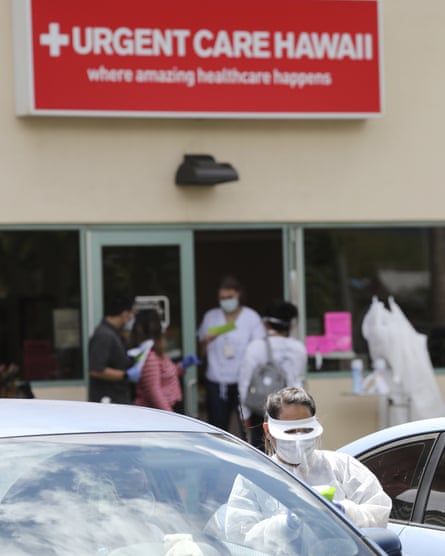In a stark proclamation, Derek SK Kawakami, the mayor of Kauai county in Hawaii, made an extraordinary announcement on Wednesday. Beginning Friday night at 9pm – until 5am daily – a mandatory curfew would be imposed on the tropical island of 72,000 residents in an effort to mitigate the spread of the coronavirus and reduce pressure on emergency and medical infrastructure.
Requesting that off-island visitors refrain from traveling to the island for recreational purposes until further notice, the mayor declared, “Kauai is on vacation” (from tourism).
The island’s first two cases of Covid-19 arrived when two visitors from the continental US flew from Maui to Kauai despite knowing they had been in contact with an infected person. After testing negative for flu on Maui, they flew to Kauai where they tested positive for the coronavirus and were put into isolation.
As of Friday morning, Hawaii had 26 confirmed cases of coronavirus, but, like the rest of the country, testing lags.
In 2018, Kauai saw a record 1.38 million visitors, but Kawakami said that marketing the island as a vacation spot during the crisis was “unacceptable and insensitive”, warning that as long as visitors come to the island, the community will be challenged to “flatten the curve”, a term that refers to slowing the rate at which a disease spreads.
The curfew, Kawakami said, had three goals: to protect and preserve limited response resources, prevent the spread of Covid-19 by increasing social distancing and allowing essential services and operations to continue.
“In order to ensure that the public is properly protected, it is prudent that we take bold steps to ensure our public safety officials and first responders and healthcare workers have the necessary environment in which to keep us all safe,” the mayor said.
With Covid-19 outbreak mushrooming across all 50 states simultaneously, Kawakami said Kauai could not expect to receive outside help in the event the island’s own limited emergency responders and medical resources were depleted or overwhelmed. The curfew, he said, will reduce stress on those resources.

The Kauai chief of police, Todd Raybuck, asked for voluntary public compliance in order to protect the community’s most vulnerable citizens and kupuna (elders). Those violating the curfew could be warned, cited or arrested.
Island visitors will be required to stay inside their hotel or lodging rooms during the curfew.
With 216,000 tourism-related jobs, curfews, closures and requests that visitors stay back is having an immediate impact on Hawaii’s largest industry, thousands of local businesses and their employees.
The Kauai Chamber of Commerce president, Mark Perriello, said he understood how difficult the mayor’s decisions were, but recognized the measures were taken to protect the health and safety of the community. Perriello encouraged local business owners to use chamber resources to navigate the upheaval. A package of $250bn in federal emergency relief funding could offer assistance to a community in shock.
On Kauai’s west side, a spokesman for the Pacific Missile Range Facility, a naval base used for testing and training missiles, rockets and military systems, said the navy was closely coordinating with county and state officials, following recommended protocols and limiting group sizes. One public event had been cancelled, but range operations remained on schedule and the airfield open, though under daily review, he said.
In contrast to Kauai, Maui county, Hawaii county, and the city and county of Honolulu, have not introduced curfews. The Honolulu mayor, Kirk Caldwell, has called for all restaurants, bars and other businesses to close most operations by 8.30pm for 15 days.
On Hawaii island, Mayor Harry Kim left business closure and operational decisions for individuals to determine, citing the island’s geographic size and unique circumstances.
On Molokai, an island in Maui county with no reported coronavirus cases, residents demonstrated outside the airport with signs calling for a halt to tourist arrivals, holding signs reading “Molokai is closed,” “Common sense – stay home” and “Keep your distance ocean length.”
For anyone who insists on visiting Hawaii for a mid-pandemic getaway, Hawaii’s lieutenant governor, Josh Green, announced their vacation will begin with a mandatory 14-day quarantine upon arrival.
